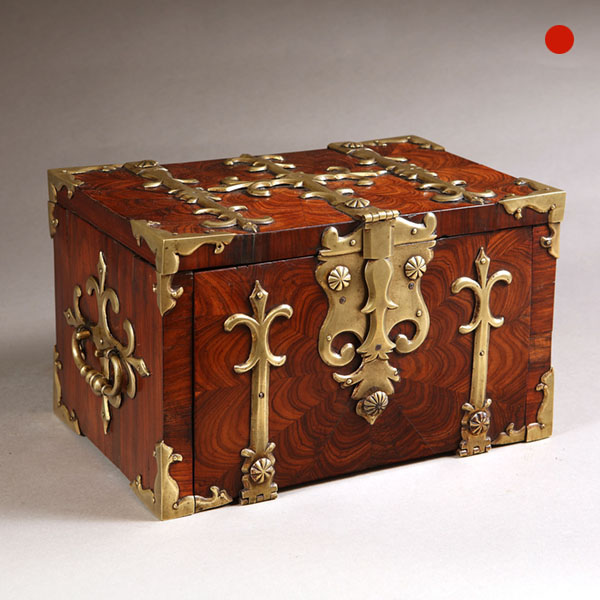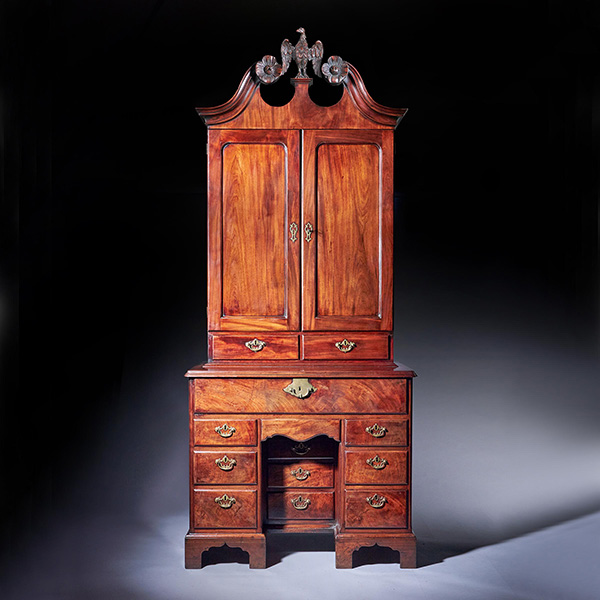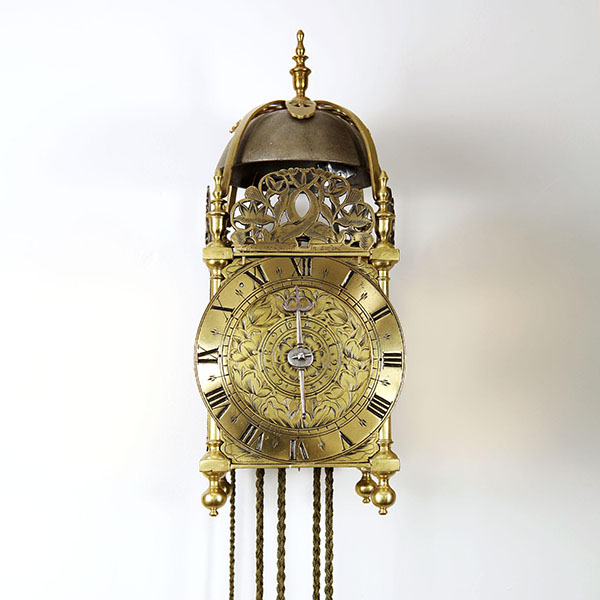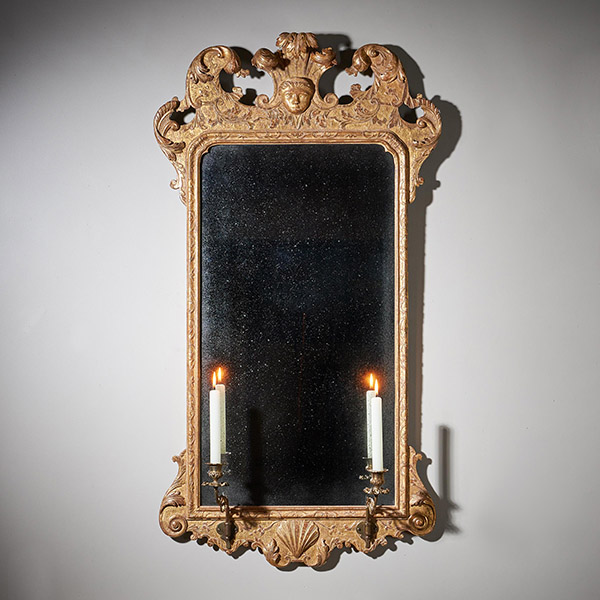Charles II olive oyster floral marquetry table
This accomplished Charles II marquetry table clearly bears the influence of Dutch and French masters of marquetry working in the last quarter of the 17th century, such as, Gerrit Jensen, Pierre Golle and Jan Van Meekeren. Golle, a Dutchman who moved to Paris to work for the court was at the forefront of richly inlaid designs of floral motifs and renowned for his marquetry of brass and tortoiseshell, made famous by his son-in-law André Charles Boulle. Golle’s son,Cornelius, emigrated after the Revocation of the Edict of Nantes (1685) and by 1689 was working with the London cabinetmaker Gerrit Jensen, supplying marquetry furniture in the latest Parisian taste to the court of William III and Mary II and Queen Anne.
In style Jensen’s furniture is consistently French in form, and particularly close to the work of Pierre Golle, Boulle’s famous predecessor. Golle’s will mentions a sum of money owed to Jensen for glue suggesting that close contact existed between the two masters. The catalyst here may well have been Golle’s brother-in-law, Daniel Marot, the Huguenot designer and engraver trained under Bérain, who left France before the Revocation of the Edict of Nantes, entering the service of William and Mary first in Holland and then in England. Marot’s engraved furniture designs show remarkable similarities with Jensen’s documented pieces in the Royal Collection, and others attributed to him at Boughton, Drayton and elsewhere. It is possible that Jensen had French craftsmen working for him: for instance, one Peter Berew, who signs a receipt on his behalf at Drayton in 1693. French terms, barely anglicized, occur constantly in the accounts, and indeed the ‘beuro’ or ‘scrutore’ (escritoire) with ‘drawers to stand on the top’ (otherwise known as the ‘caddinet’) may be a form which Jensen introduced to this country from France, together with the narrow gateleg table with a folding top.
Gerrit Jensen was one of the foremost cabinet-makers of his day and worked in London from his premises in St. Martin’s Lane. Jensen served the English crown since the reign of Charles II as the accounts of the Royal Household record a payment to him in 1680, for furniture which King Charles II commissioned as a royal gift for the King of Morocco. In 1689, Jensen was appointed royal cabinetmaker to King William III and Queen Mary – ‘Cabinet maker in Ordinary’ to the Crown; and he retained his royal appointment throughout the reign of Queen Anne, supplying furniture for St. James’s Palace, Hampton Court and Kensington Palace. In addition to the Royal family and the Dukes of Devonshire, Jensen also attracted commissions from senior members of the nobility, including the Dukes of Richmond, Hamilton, Montagu and Somerset, collaborating with other leading artists and craftsmen on the decoration of some of the greatest town and country houses in England. Jensen was one of several artist-craftsmen of foreign background employed at the English court, and his work shows a strong Continental influence, reflecting the fashionable French court styles of Pierre Golle, André Charles Boulle and Daniel Marot earning him the title ‘the English Boulle’.
Further stylistic and circumstantial evidence supporting the attribution to Gerrit Jensen in association with Pierre Golle, is in part from a number of tables with attribution to Jensen at Ham House, Chatsworth and Beningbrough Hall, an olive oyster cabinet on chest from Chatsworth House, a cushion mirror in the Boston Museum of Art, a further cushion mirror at Ham House, a cabinet in the Rijkesmuseum, an unattributed table in the V&A and a cabinet from Levens Hall. We also take a brief look into other collaborations and possibility’s in the royal collection. It should be noted like our example all legs to the aforementioned tables and the cabinet from Levens Hall, along with a table possibly commissioned by Charles II in the royal collection, share the distinctive barley or Solomonic twists, with decoration to the stretchers, excluding the example at Beningbrough Hall, which is on broken scroll legs and a table at Chatsworth House, which has broken S-scroll legs into carved gilt mask capitals, raised on carved gilt feet. The construction and use of materials on our table is plausibly ‘identical’ to that of the tables we have studied excluding that at the royal collection, as it does not have a drawer.
Condition
Of excellent original colour and surface, original handles, legs and stretcher, later bun feet. ‘Museum Condition’
Dimensions
H 28.5 in. x W 38.5 in. x D 36.5 in.
H 72.39 cm x W 97.79 cm x D 92.71 cm
Provenance
Nocton Hall, Lincoln
Comparable Tables
Auction Results
Lot 36, Sotheby’s Paris September 30th 2011 – A RED TORTOISESHELL, IVORY AND BONE INLAID AND FLORAL MARQUETRY TABLE, LOUIS XIV, CIRCA 1665, ATTRIBUTED TO PIERRE GOLE (http://www.sothebys.com/en/auctions/ecatalogue/2011/important-mobilier-sculptures-et-objets-dart-pf1111/lot.36.html)
Lot 130, Christies London July 6th 2000 – A GEORGE I WALNUT TABLE WITH CHARLES II MARQUETRY TOP
Possibly by Pierre Gole (https://www.christies.com/lotfinder/lot/a-george-i-walnut- table-with-charles-1834901-details.aspx?from=searchresults&intObjectID=1834901&sid=2c374e29-d9f5-4b96-9a56-b780a655e700)
Literature
A History Of English Furniture, By Percy MacQuoid, Page 148, plate XXII – Property of Lord Zouch of Haryngworth.
English Furniture 1660-1714 From Charles II to Queen Anne, By Adam Bowett – Page 60, Page 61 Plate 2:43 (1675-90), Page 116 Plate: 4:20 (1684), Page 117 Plate: 4:21, (1670-85), Page 118 Plate: 4:22 (1680).
Dictionary Of English Furniture Makers 1660-1840, Furniture History Society – Gole, Cornelius, page 348.
Dictionary Of English Furniture Makers 1660-1840, Furniture History Society – Jensen, Gerrit, page 485, 486, 487.
PREVIOUSLY SOLD

William and Mary Kingwood or ‘Princes’ wood oyster cabinet on chest
When the most expensive timber of the 17th century met Thomas Pistor. There were, in fact, two cabinet-makers called Thomas Pistor, father and son, working for a period at the same time but at different premises. One or both are known to have made furniture of quality for Levens Hall.

17th Century William and Mary Kingwood Strongbox
A 17th century William and Mary Kingwood strongbox, with gilt brass straps. This strongbox has to be one of the most charming and certainly the smallest example we have encountered, at just 17.5 cm high, 28 cm wide and 18 cm deep. A strongbox of similar merit form and style resides at Burghley House in ‘The 1st George State Room.

18th Century George III Mahogany Serpentine Chest or Commode
A fine George III mahogany serpentine commode, England, circa 1770. Attributed to Henry Hill, Marlborough. The three graduated drawers retain their original gilt brass handles over a unique carved apron and flanked by moulded angles continuing into the shaped cabriole feet.

George I Burr and Highly Figured Walnut Lowboy, Circa 1720
George I Burr and Highly Figured Walnut Lowboy Circa 1720. England SOLD Follow UsGeorge I Burr and Highly Figured Walnut Lowboy, Circa 1720. England The feather and cross banded top is quarter veneered with burr walnut and edged with a...

18th-Century George III fitted miniature burr yew and satinwood chest attributed to Ince and Mayhew
A perfectly proportioned miniature chest attributed to Ince and Mayhew. The miniature is of a style that thrived in the latter part of the 18th century, proving popular with nobility and the middle classes. I am not aware of another miniature chest thought to be by eminent makers.

George III Mahogany Serpentine Chest of Drawers
Georgian perfection, 18th century George III mahogany serpentine chest of drawers with brushing slide, fabulous reeded columns and retaining superb original age patinated surface. Choice cuts of flame mahogany veneer sit below the brushing-slide to the four oak lined cock-beaded graduating drawers, which are fitted with their original gilt swan-neck handles, skeleton escutcheons and locks.

William and Mary Kingwood or ‘Princes’ wood oyster cabinet on chest
When the most expensive timber of the 17th century met Thomas Pistor. There were, in fact, two cabinet-makers called Thomas Pistor, father and son, working for a period at the same time but at different premises. One or both are known to have made furniture of quality for Levens Hall.

17th Century William and Mary Kingwood Strongbox
A 17th century William and Mary Kingwood strongbox, with gilt brass straps. This strongbox has to be one of the most charming and certainly the smallest example we have encountered, at just 17.5 cm high, 28 cm wide and 18 cm deep. A strongbox of similar merit form and style resides at Burghley House in ‘The 1st George State Room.

18th Century George III Mahogany Serpentine Chest or Commode
A fine George III mahogany serpentine commode, England, circa 1770. Attributed to Henry Hill, Marlborough. The three graduated drawers retain their original gilt brass handles over a unique carved apron and flanked by moulded angles continuing into the shaped cabriole feet.

George I Burr and Highly Figured Walnut Lowboy, Circa 1720
George I Burr and Highly Figured Walnut Lowboy Circa 1720. England SOLD Follow UsGeorge I Burr and Highly Figured Walnut Lowboy, Circa 1720. England The feather and cross banded top is quarter veneered with burr walnut and edged with a...

18th-Century George III fitted miniature burr yew and satinwood chest attributed to Ince and Mayhew
A perfectly proportioned miniature chest attributed to Ince and Mayhew. The miniature is of a style that thrived in the latter part of the 18th century, proving popular with nobility and the middle classes. I am not aware of another miniature chest thought to be by eminent makers.

George III Mahogany Serpentine Chest of Drawers
Georgian perfection, 18th century George III mahogany serpentine chest of drawers with brushing slide, fabulous reeded columns and retaining superb original age patinated surface. Choice cuts of flame mahogany veneer sit below the brushing-slide to the four oak lined cock-beaded graduating drawers, which are fitted with their original gilt swan-neck handles, skeleton escutcheons and locks.
YOU MAY ALSO LIKE

18th Century George III Carved Mahogany Serpentine Concertina Action Card Table
18th Century George III Carved Mahogany Serpentine Concertina Action Card Table £19,800Follow Us18th Century George III Carved Mahogany Serpentine Concertina Action Card Table A bold and impressive George III carved mahogany serpentine...

A George II Irish Mahogany Secretaire Kneehole Bookcase Att. C. Hearn
A George II Irish Mahogany Secretaire Kneehole Bookcase Att. C. Hearn £45,900Follow UsA George II Irish Mahogany Secretaire Kneehole Bookcase Att. C. Hearn An original and rare two-part George II 18th century Irish architects figured mahogany...

17th Century Lantern Alarm Clock by Johannes Quelch, Oxford
17th Century Lantern Alarm Clock by Johannes Quelch, Oxford £14,000Follow Us17th Century Lantern Alarm Clock by Johannes Quelch, Oxford An English 17th century lantern clock made of brass and iron, circa 1665-1670. The clock consists of going...

19th-Century Flame Mahogany Mantel Clock by BREGUET Raised by Lion Paw Feet
19th-Century Flame Mahogany Mantel Clock by BREGUET Raised by Lion Paw Feet £23,500Follow Us19th-Century Flame Mahogany Mantel Clock by BREGUET Raised by Lion Paw Feet EXTREMELY RARE MANTEL CLOCK WITH A FIGURED MAHOGANY-VENEERED CASE by A-L...

Unusual Ribbed Eight-Day Repeating Striking Gilt-Brass Gorge Case Carriage Clock
Unusual Ribbed Eight-Day Repeating Striking Gilt-Brass Gorge Case Carriage Clock £4,850Follow UsUnusual Ribbed Eight-Day Repeating Striking Gilt-Brass Gorge Case Carriage Clock CaseThe clock has a gilt-brass case which is a variation on the...

Fine 18th Century George I Gilt Gesso Pier or Console Mirror, Manner of Belchier
Fine 18th Century George I Gilt Gesso Pier or Console Mirror, Manner of Belchier £13,900Follow UsFine 18th Century George I Gilt Gesso Pier or Console Mirror, Manner of Belchier A fine and rare early 18th century George I Gilt Gesso pier or...

18th Century George III Carved Mahogany Serpentine Concertina Action Card Table
18th Century George III Carved Mahogany Serpentine Concertina Action Card Table £19,800Follow Us18th Century George III Carved Mahogany Serpentine Concertina Action Card Table A bold and impressive George III carved mahogany serpentine...

A George II Irish Mahogany Secretaire Kneehole Bookcase Att. C. Hearn
A George II Irish Mahogany Secretaire Kneehole Bookcase Att. C. Hearn £45,900Follow UsA George II Irish Mahogany Secretaire Kneehole Bookcase Att. C. Hearn An original and rare two-part George II 18th century Irish architects figured mahogany...

17th Century Lantern Alarm Clock by Johannes Quelch, Oxford
17th Century Lantern Alarm Clock by Johannes Quelch, Oxford £14,000Follow Us17th Century Lantern Alarm Clock by Johannes Quelch, Oxford An English 17th century lantern clock made of brass and iron, circa 1665-1670. The clock consists of going...

19th-Century Flame Mahogany Mantel Clock by BREGUET Raised by Lion Paw Feet
19th-Century Flame Mahogany Mantel Clock by BREGUET Raised by Lion Paw Feet £23,500Follow Us19th-Century Flame Mahogany Mantel Clock by BREGUET Raised by Lion Paw Feet EXTREMELY RARE MANTEL CLOCK WITH A FIGURED MAHOGANY-VENEERED CASE by A-L...

Unusual Ribbed Eight-Day Repeating Striking Gilt-Brass Gorge Case Carriage Clock
Unusual Ribbed Eight-Day Repeating Striking Gilt-Brass Gorge Case Carriage Clock £4,850Follow UsUnusual Ribbed Eight-Day Repeating Striking Gilt-Brass Gorge Case Carriage Clock CaseThe clock has a gilt-brass case which is a variation on the...

Fine 18th Century George I Gilt Gesso Pier or Console Mirror, Manner of Belchier
Fine 18th Century George I Gilt Gesso Pier or Console Mirror, Manner of Belchier £13,900Follow UsFine 18th Century George I Gilt Gesso Pier or Console Mirror, Manner of Belchier A fine and rare early 18th century George I Gilt Gesso pier or...










